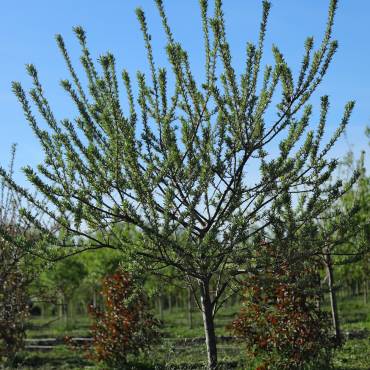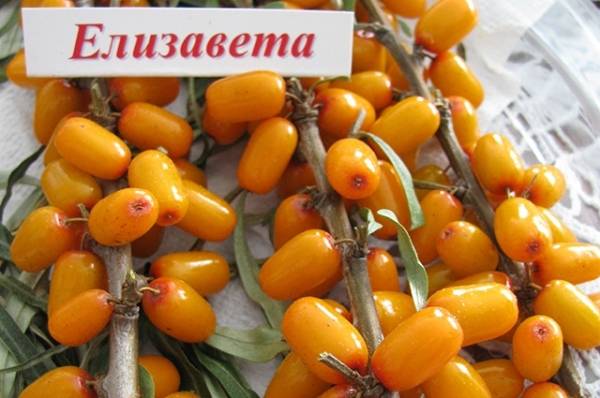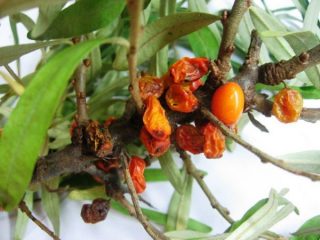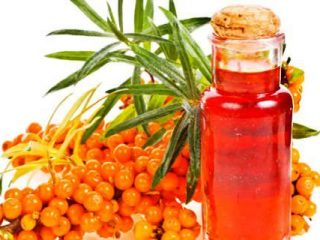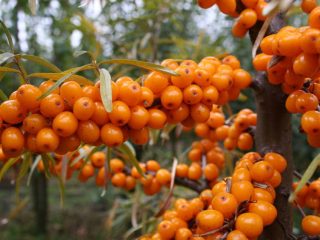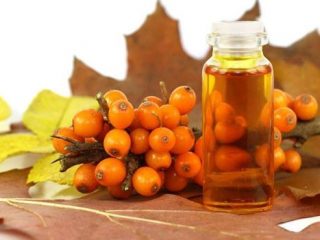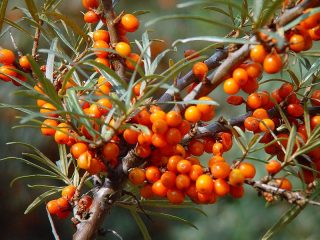Content
Sea buckthorn Elizabeth is the reason for the revival of interest in planting this culture. Thanks to the painstaking process of selection and breeding of a new variety, it was possible to minimize the disadvantages that were previously encountered in other sea buckthorn varieties.
Breeding history
The beginning of work on the breeding of the Elizaveta variety is considered to be 1981, when a domestic scientist, Doctor of Agricultural Sciences Elizaveta Panteleeva, began to breed sea buckthorn seeds of the Panteleevskaya variety.
These seeds have been pretreated with a chemical that generates mutation in plant cells. So, after 16 years of careful selection of the resulting crops, a new variety of sea buckthorn Elizabeth was bred. In 1997, the variety was brought to Rosreestr and recommended for cultivation.
Description of berry culture
Sea buckthorn Elizaveta is a variety with high yields and good taste. The culture is decorative and large-fruited, due to which it has become widespread.
General understanding of the variety
The Elizaveta variety is a dwarf shrub with a small crown. The leaves have a characteristic elongated shape for this plant, as well as various colors - dark green at the top and olive with a silvery sheen in the lower part of the shrub.
Below is a photo of the sea buckthorn Elizabeth, which shows that the crown of the bush is most often oval or spherical in shape. This variety has very few thorns.
Berries
The description of the sea buckthorn Elizabeth also includes the characteristics of the fruit. The berries are about 1-1.2 cm long, elongated, resembling a cylinder. On average, the weight of one sea buckthorn fruit is about 1 g. The pulp is dense and juicy, because it contains 10% sugar.
Characteristic
The characteristics of the sea buckthorn variety Elizaveta allows you to get complete information about the flowering and ripening times of the plant, the main advantages of the variety, as well as the areas of application of the sea buckthorn fruits.
Main advantages
Elizaveta differs from other varieties of sea buckthorn in unpretentious care, high yield rates and resistance to low temperatures. To verify this, a comparison can be made between different varieties of sea buckthorn. For example, sea buckthorn Elizaveta and Druzhina are considered large-fruited varieties, but the weight of berries and yield indicators for the Elizaveta variety are greater.
Flowering period and ripening time
The flowering period of the berry culture falls on the end of April - beginning of May. The fruits begin to ripen in the third decade of August, therefore Elizabeth is considered a late variety of sea buckthorn.
Yield indicators, fruiting dates
A high yield rate is one of the main features characteristic of the Elizaveta variety. More than 12 kg of berries are harvested from one adult bush. In this case, regular fruiting occurs already at the 4th year of the plant's life.
A shrub can bear fruit for 10-12 years, after which it must be regularly rejuvenated or new plants obtained from cuttings of this tree must be planted.
Scope of berries
Elizabeth belongs to dessert varieties, so the berries can be used both in pure form and for preparing various dishes and desserts, or alternative medicine.
Disease and pest resistance
The sea buckthorn variety Elizaveta is distinguished by strong immunity against many diseases and pests. Proper care and prevention increases the plant's resistance to diseases and reduces the growth of pests.
Advantages and disadvantages of the variety
The main advantages of sea buckthorn Elizabeth:
- large-fruited;
- taste of berries;
- decorativeness of the shrub;
- high yield rates;
- excellent tolerance to low temperatures;
- resistance to diseases and pests.
The disadvantages of culture include:
- late fruiting;
- self-infertility;
- sensitivity to sudden changes in temperature and humidity.
Despite the weaknesses, Elizabeth is still considered one of the best dessert and large-fruited varieties.
Landing rules
Cultivation of sea buckthorn Elizabeth has its own characteristics. The choice of the place and timing of planting, as well as the careful selection of the seedling, plays an important role in the further growth and development of berry culture.
Recommended timing
Sea buckthorn is planted in spring or autumn. In the first case, organic fertilizers must be applied to the soil, and then the plant must be properly cared for. If planting is carried out in the fall, then it is worth making sure of the integrity of the root system. The seedling must be covered with dense material until spring.
Choosing the right place
The optimal place for planting a seedling is the southern, sunny side of the site. Many reviews of Elizabeth sea buckthorn contain information that the culture prefers sandy soils with a neutral or alkaline pH.
Therefore, it is worth stopping your choice on areas next to fences or small buildings.
Soil preparation
Preparation of a pit for planting a sea buckthorn seedling is carried out in about a month (if planting is planned in the fall), or six months (if in spring). It is necessary to dig a hole with a diameter and depth of 50 cm. Then prepare and pour into the hole a substrate from a mixture of humus and sand with a small addition of ash.
Selection and preparation of seedlings
When buying seedlings, pay attention to the planting material. The seedling should not have any damage, and the root system should be healthy.
To obtain a rich harvest, it is necessary to purchase two seedlings at once: male and female. They differ in the shape of the buds and the number of scales. On the female plant, the buds have an elongated shape and a maximum of 3 scales, and on the male plant, the buds are rounded with up to 7 scales.
Algorithm and scheme of landing
Planting sea buckthorn Elizabeth is carried out in several stages:
- Pit and soil preparation.
- Placing a seedling in the center of the hole and spreading the root system.
- Substrate introduction into the pit.
- Compaction of the soil.
- Watering the land and mulching it with sawdust with the addition of peat.
For stability, the seedling is tied to a peg.
Follow-up care of the culture
Planting and caring for sea buckthorn Elizabeth, as mentioned earlier, has its own characteristics. The plant requires a certain watering regime, regular fertilization, as well as taking measures to combat diseases and pests.
Necessary activities
Despite the fact that the culture is drought-resistant, do not forget about watering the plant. In no case should the soil dry out and crack, but sea buckthorn also does not tolerate stagnant water. The irrigation regime depends on the region and climate in which the shrub grows. On average, an adult tree uses about 35 liters of water at a time.
In the first three years of the plant's life, no fertilization is needed. After that, it is recommended to feed the plant with ammonium nitrate, and after flowering - with potassium humate in liquid form. For autumn, wood ash mixed with superphosphate and potassium salt is perfect.
Shrub pruning
The height of the sea buckthorn Elizabeth is on average about 2.5 meters, but to obtain a richer harvest and the formation of a neat crown, the shrub is pruned. The procedure is performed twice a year:
- in early spring;
- in the fall.
In both cases, pruning is of a sanitary nature - all dead, dried and damaged shoots are removed.
Preparing for winter
Sea buckthorn is a frost-resistant shrub, so no preparation of the plant for winter is necessary.
Diseases and pests, methods of control and prevention
This berry culture shows a fairly strong immunity to diseases, numerous reviews of the sea buckthorn variety Elizabeth confirm this. However, improper plant care can cause any disease or insect damage.
Diseases | Methods of control and prevention |
Endomycosis | Spraying with copper chloride twice a year: as soon as the shrub blooms, and then in July. |
Blackleg | Watering the seedlings once every few days with a solution of potassium manganese. |
Scab | Shrub treatment with Bordeaux mixture one month before harvesting. |
Pests | Preventive measures and methods of destruction |
Sea buckthorn moth | The plant is sprayed during the period of bud swelling with a solution of "Karbofos". |
Gall mite | With a slight lesion, the plant is sprayed with a decoction of onion peel, otherwise it is treated with insecticidal preparations. |
Sea buckthorn fly | The shrub is sprayed with Chlorophos solution in mid-July. |
Conclusion
Sea buckthorn Elizaveta is one of the best varieties of berry culture. Its advantages are large-fruited, high yield, low temperature tolerance, as well as immunity to most diseases and pests.
